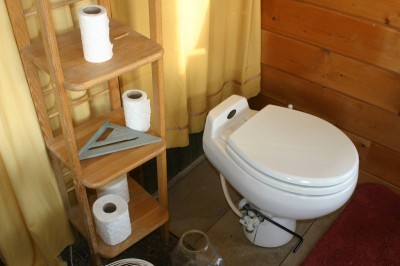






Using composting toilets can help reduce water usage. This type of toilet consists of a well-ventilated container that houses and decomposes human waste.
Unlike conventional toilet systems, there is no flushing involved. Compost toilets depend on aerobic bacteria to break down waste, similar to that of outdoor composting. Rather than flushing, waste is composted with carbon-rich sources like wood shavings, bark mulch, leaves, etc. The end product, as with any compost, is a soil-like material similar to humus.
While the disposal of this humus is occasionally permitted in non-edible garden soils, depending on where you live, this compost is generally hauled away. This must be done by a licensed septic hauler in your area.
There are several composting toilet systems, depending on your needs. Regardless of the type chosen, however, they all share the same basic features. All will generally require the use of electricity (for heaters or fans), a composting container, an air and exhaust system, and an access door for emptying.
In addition to these systems, you will find what is referred to as true toilet and dry toilet systems.
As with anything in life, there are both advantages and disadvantages to using compost toilets.
Some of the advantages include the fact that they are more environmentally friendly. They require less water usage and can enhance the growth of non-edible plants in locations where soil amendment is permitted. In addition, they are well suited to remote areas.
Disadvantages of a compost toilet include more maintenance than standard toilets. Improperly or poorly maintained systems can lead to odors, insects, and health hazards. These toilets usually require some type of power source, and the end product must also be removed. In addition, too much liquid can lead to slower decomposition.
With proper care and maintenance, a composting toilet can be a safe and cost-effective alternative to traditional flushing toilets.
weeping willow and the tropics.
D. multifida and the D. scorpiodes
Discover the many benefits and advantages of using a lawn care professional
Discover the many benefits and advantages of using tree surgery services
The Advantages of Soiless Gardening
Copyright © www.100flowers.win Botanic Garden All Rights Reserved